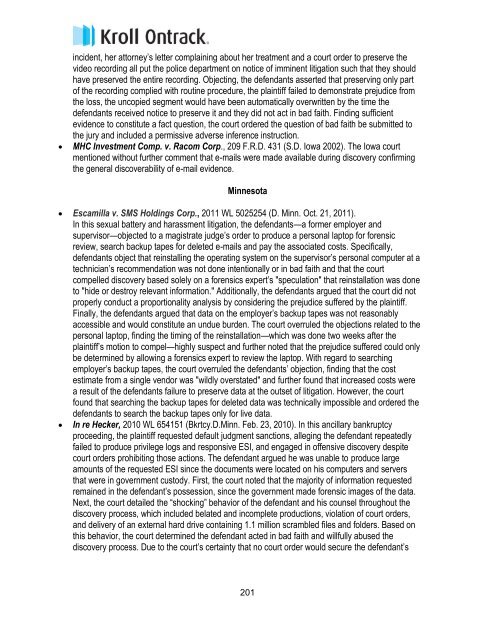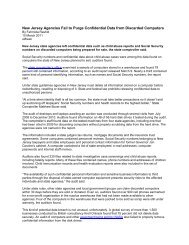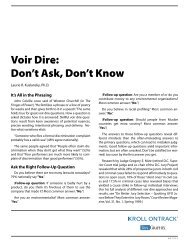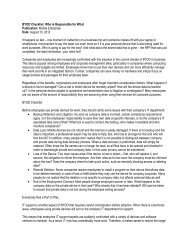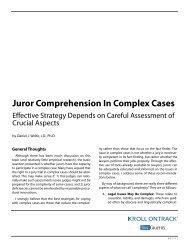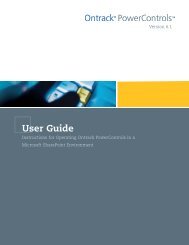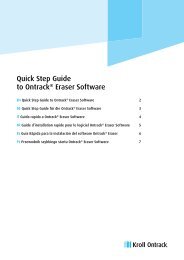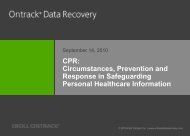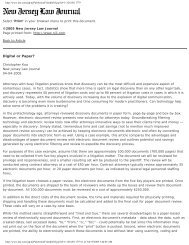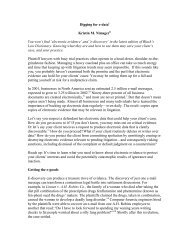Electronic Discovery and Computer Forensics Case List - Kroll Ontrack
Electronic Discovery and Computer Forensics Case List - Kroll Ontrack
Electronic Discovery and Computer Forensics Case List - Kroll Ontrack
Create successful ePaper yourself
Turn your PDF publications into a flip-book with our unique Google optimized e-Paper software.
incident, her attorney’s letter complaining about her treatment <strong>and</strong> a court order to preserve the<br />
video recording all put the police department on notice of imminent litigation such that they should<br />
have preserved the entire recording. Objecting, the defendants asserted that preserving only part<br />
of the recording complied with routine procedure, the plaintiff failed to demonstrate prejudice from<br />
the loss, the uncopied segment would have been automatically overwritten by the time the<br />
defendants received notice to preserve it <strong>and</strong> they did not act in bad faith. Finding sufficient<br />
evidence to constitute a fact question, the court ordered the question of bad faith be submitted to<br />
the jury <strong>and</strong> included a permissive adverse inference instruction.<br />
� MHC Investment Comp. v. Racom Corp., 209 F.R.D. 431 (S.D. Iowa 2002). The Iowa court<br />
mentioned without further comment that e-mails were made available during discovery confirming<br />
the general discoverability of e-mail evidence.<br />
Minnesota<br />
� Escamilla v. SMS Holdings Corp., 2011 WL 5025254 (D. Minn. Oct. 21, 2011).<br />
In this sexual battery <strong>and</strong> harassment litigation, the defendants—a former employer <strong>and</strong><br />
supervisor—objected to a magistrate judge’s order to produce a personal laptop for forensic<br />
review, search backup tapes for deleted e-mails <strong>and</strong> pay the associated costs. Specifically,<br />
defendants object that reinstalling the operating system on the supervisor’s personal computer at a<br />
technician’s recommendation was not done intentionally or in bad faith <strong>and</strong> that the court<br />
compelled discovery based solely on a forensics expert’s "speculation" that reinstallation was done<br />
to "hide or destroy relevant information." Additionally, the defendants argued that the court did not<br />
properly conduct a proportionality analysis by considering the prejudice suffered by the plaintiff.<br />
Finally, the defendants argued that data on the employer’s backup tapes was not reasonably<br />
accessible <strong>and</strong> would constitute an undue burden. The court overruled the objections related to the<br />
personal laptop, finding the timing of the reinstallation—which was done two weeks after the<br />
plaintiff’s motion to compel—highly suspect <strong>and</strong> further noted that the prejudice suffered could only<br />
be determined by allowing a forensics expert to review the laptop. With regard to searching<br />
employer’s backup tapes, the court overruled the defendants’ objection, finding that the cost<br />
estimate from a single vendor was "wildly overstated" <strong>and</strong> further found that increased costs were<br />
a result of the defendants failure to preserve data at the outset of litigation. However, the court<br />
found that searching the backup tapes for deleted data was technically impossible <strong>and</strong> ordered the<br />
defendants to search the backup tapes only for live data.<br />
� In re Hecker, 2010 WL 654151 (Bkrtcy.D.Minn. Feb. 23, 2010). In this ancillary bankruptcy<br />
proceeding, the plaintiff requested default judgment sanctions, alleging the defendant repeatedly<br />
failed to produce privilege logs <strong>and</strong> responsive ESI, <strong>and</strong> engaged in offensive discovery despite<br />
court orders prohibiting those actions. The defendant argued he was unable to produce large<br />
amounts of the requested ESI since the documents were located on his computers <strong>and</strong> servers<br />
that were in government custody. First, the court noted that the majority of information requested<br />
remained in the defendant’s possession, since the government made forensic images of the data.<br />
Next, the court detailed the “shocking” behavior of the defendant <strong>and</strong> his counsel throughout the<br />
discovery process, which included belated <strong>and</strong> incomplete productions, violation of court orders,<br />
<strong>and</strong> delivery of an external hard drive containing 1.1 million scrambled files <strong>and</strong> folders. Based on<br />
this behavior, the court determined the defendant acted in bad faith <strong>and</strong> willfully abused the<br />
discovery process. Due to the court’s certainty that no court order would secure the defendant’s<br />
201


